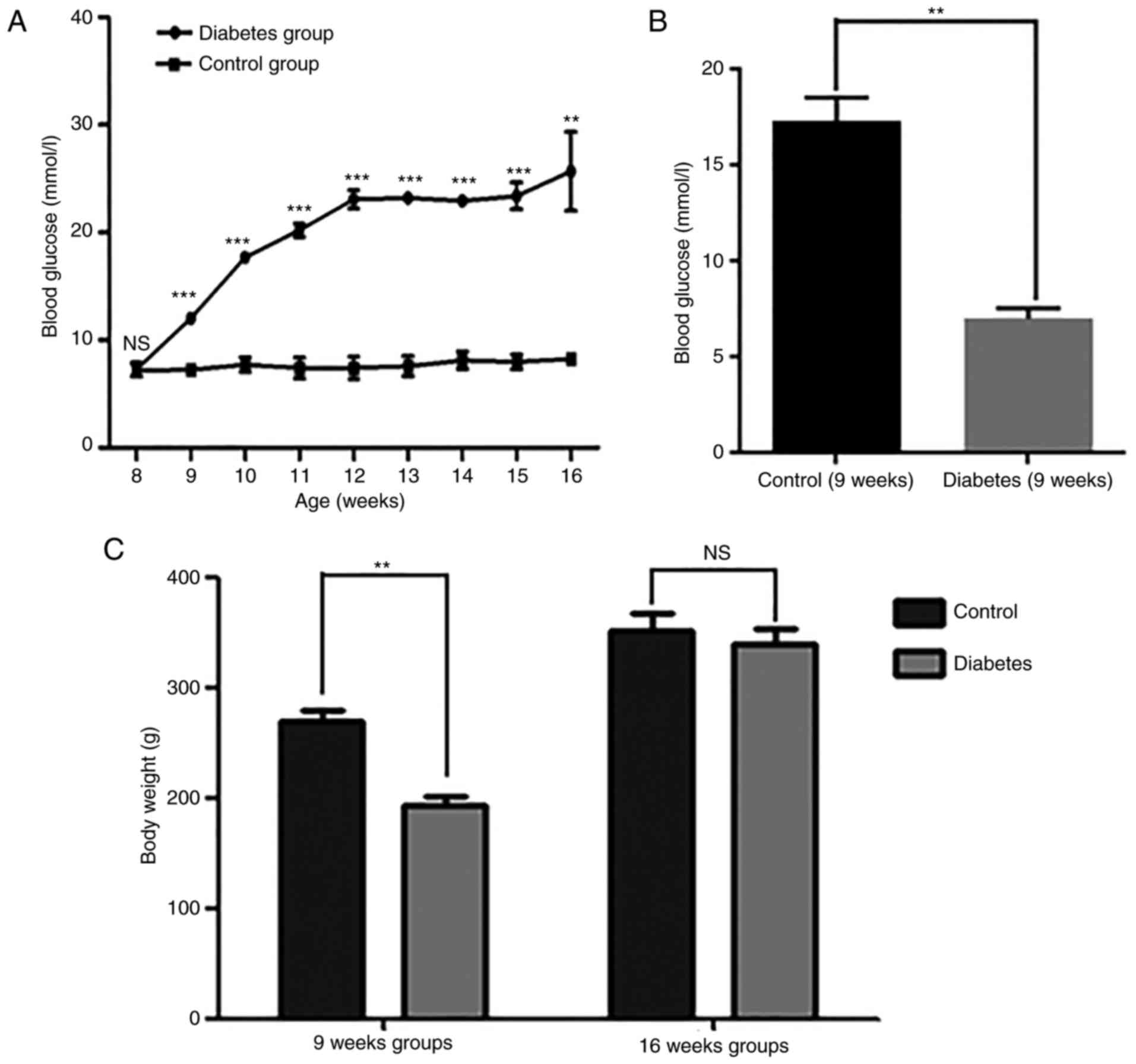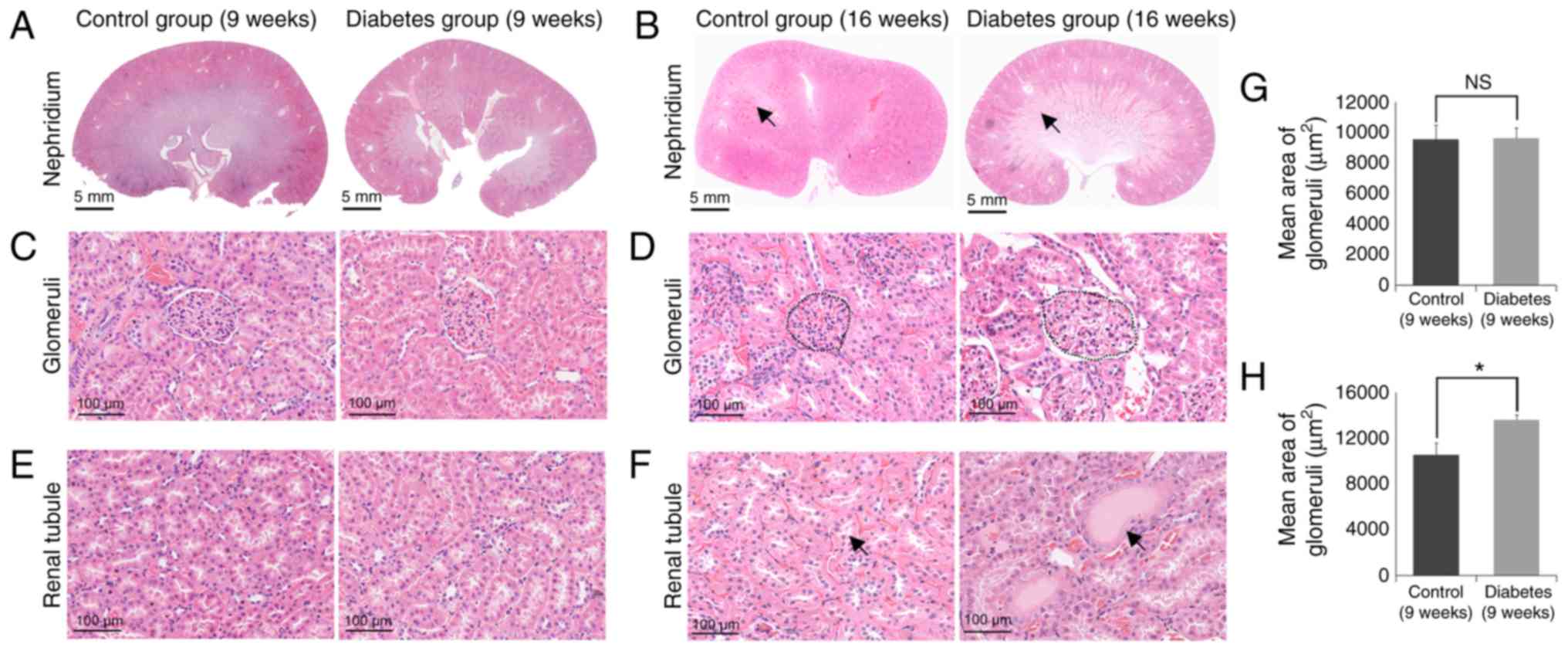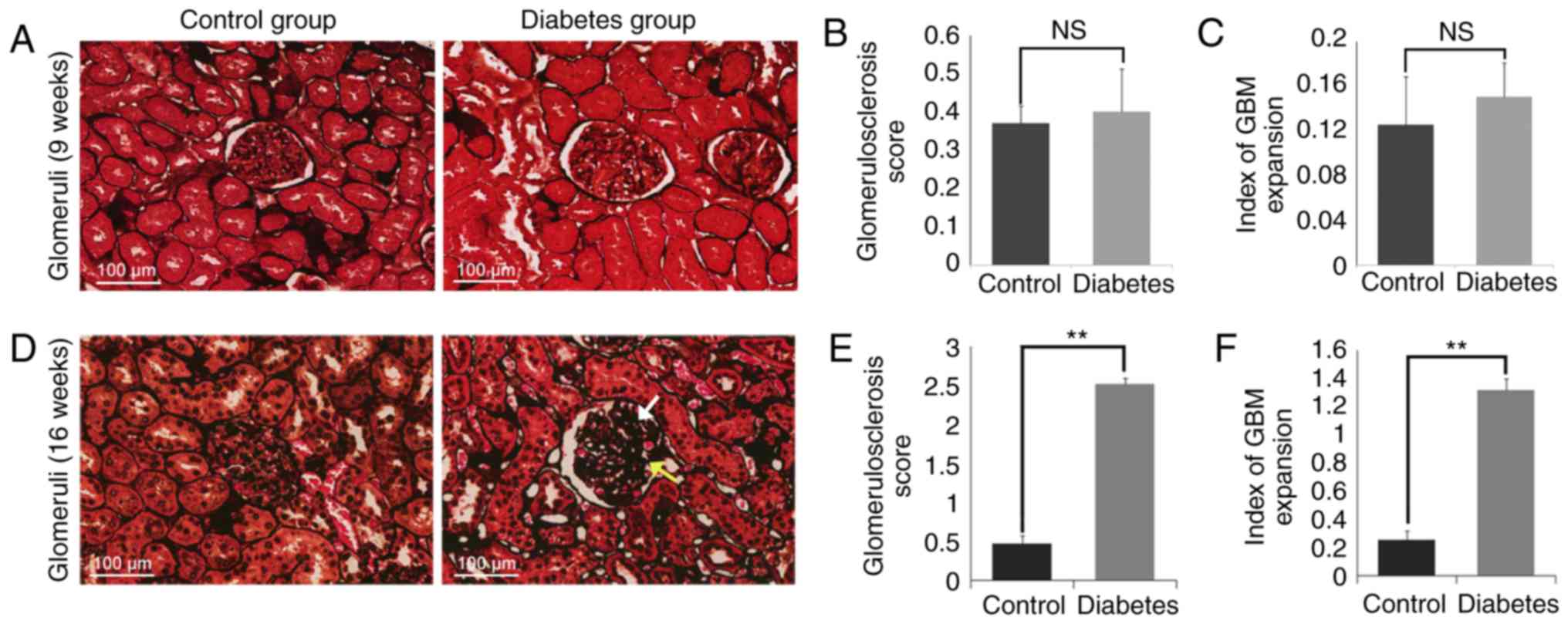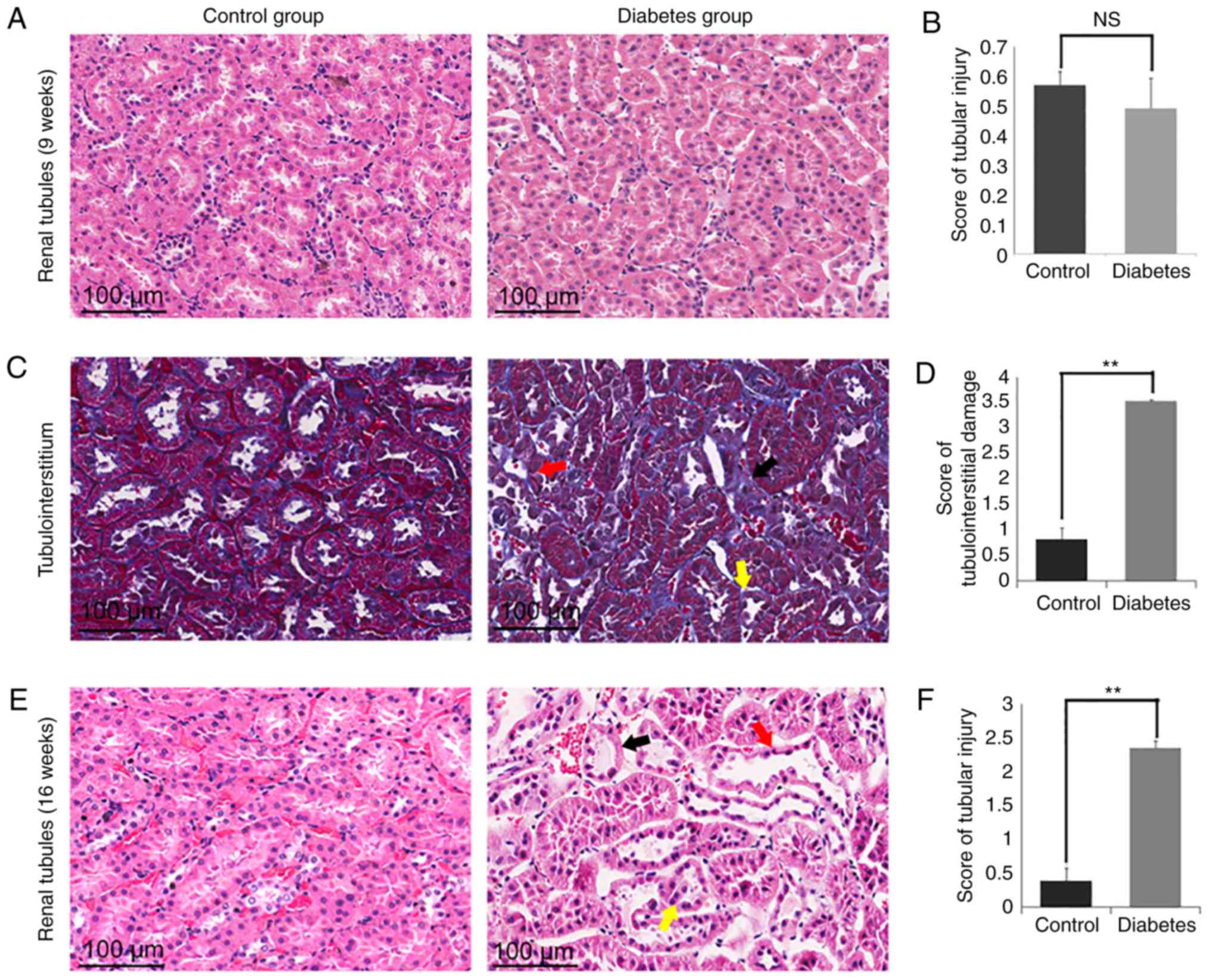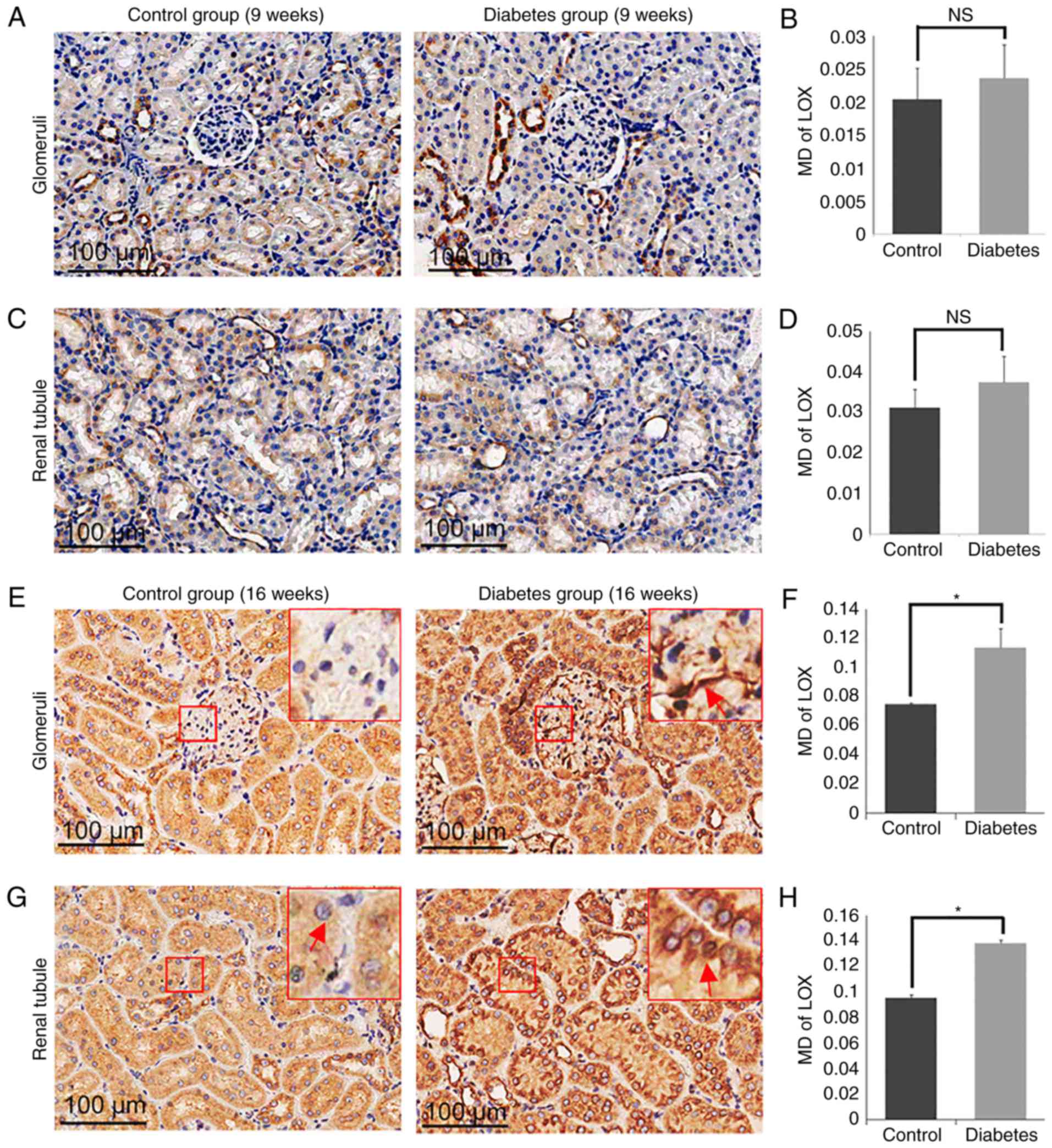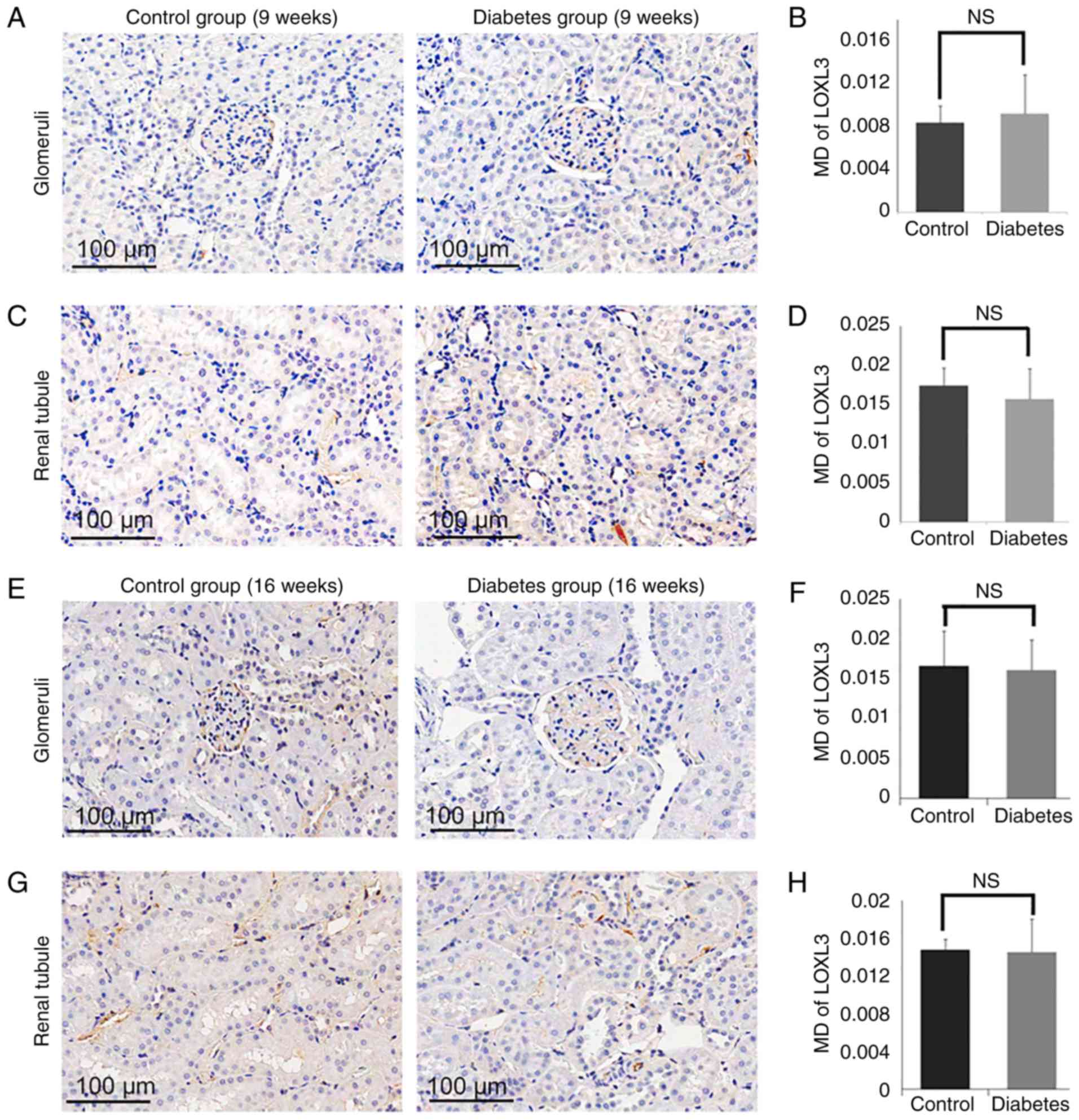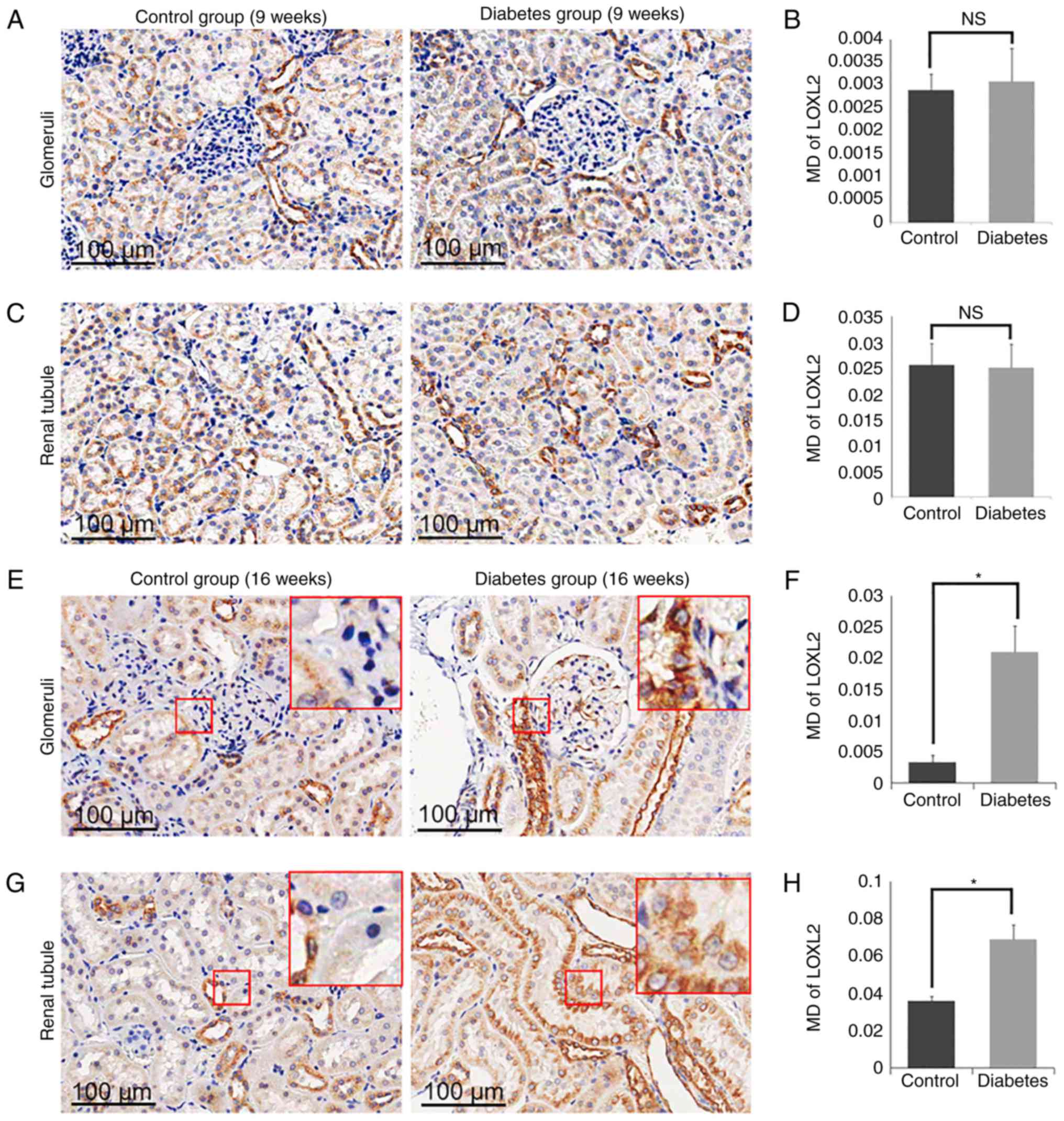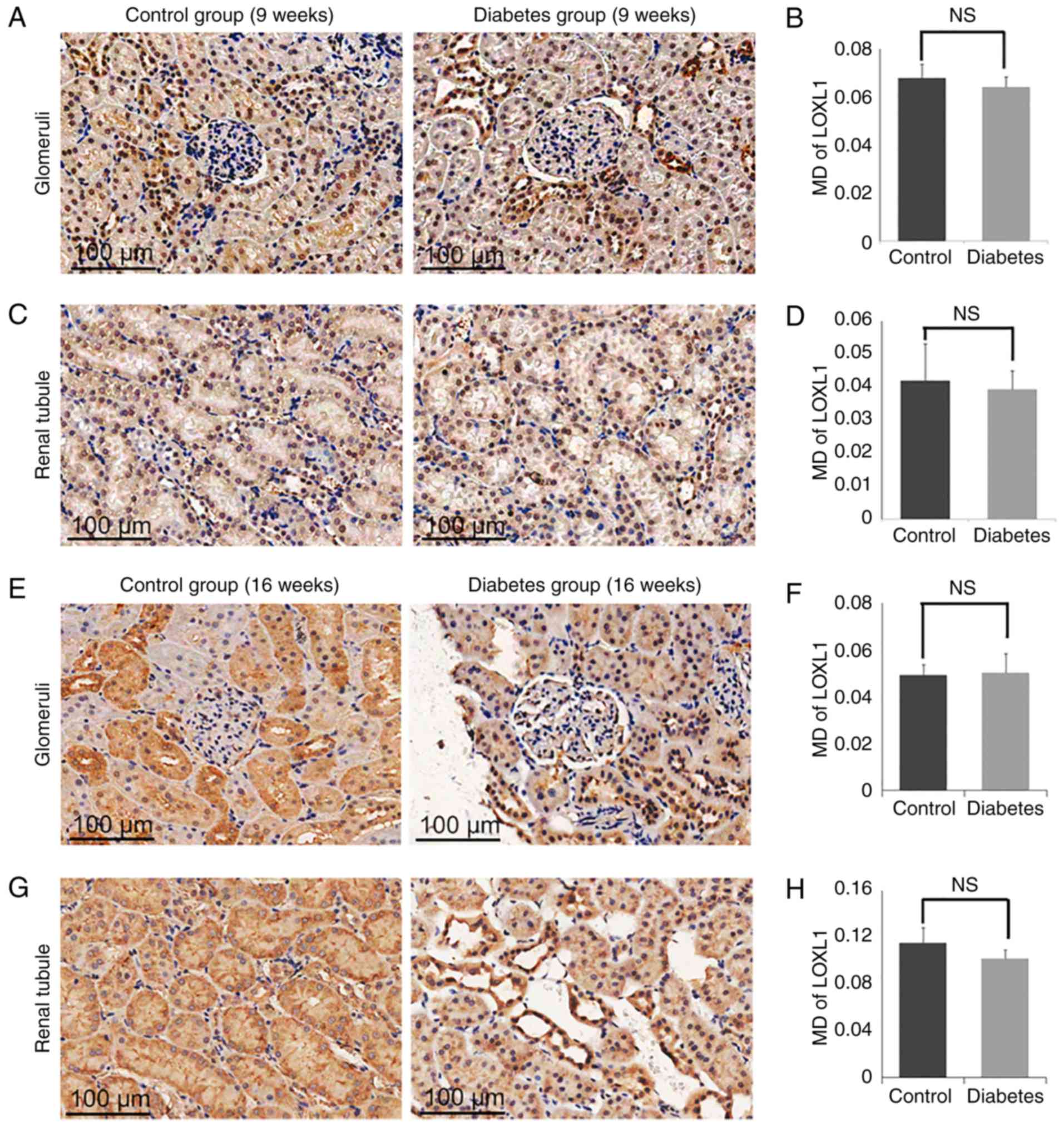Lysyl oxidases expression and histopathological changes of the diabetic rat nephron
- Authors:
- Published online on: November 29, 2017 https://doi.org/10.3892/mmr.2017.8182
- Pages: 2431-2441
-
Copyright: © Chen et al. This is an open access article distributed under the terms of Creative Commons Attribution License.
Abstract
Introduction
Diabetic nephropathy (DN) is one of the major complications of diabetes, and is a major cause of end-stage renal disease worldwide (1). Since the rise in the incidence of obesity and type 2 diabetes, high morbidity and mortality associated with DN (2,3). Over the past few decades, even though big strides have been made in improving diagnosis and treatment of DN patients, we are still unable to dramatically reduce the mortality of diabetic patients worldwide. Nevertheless, if therapeutic interventions start in the early stages of DN, its pathophysiological progression can be slowed down considerably (4–6). Therefore, there is urgent need to identify key biomarkers to correctly classify the clinical stage of DN. Recent study found Hydrogen sulfide possessed important therapeutic characteristics that prevented the development of DN (7). However, many studies are conflicting regarding the specificity and sensitivity of biomarkers currently used in clinical practice for DN diagnosis (8,9). Recent studies suggest that the membrane attack complex and levels of mannose-binding lectin might contribute to renal damage in the hyperglycaemic mileu (10) and reticulum stress response in renal cells is a key factor of progression of DN (11).
As a diabetic microangiopathy, the pathogenesis of DN begins with thickening of the glomerular basement membrane (GBM) and glomerulosclerosis (12). The damage to the capillaries in the kidneys' glomeruli by the GBM thickening and increased mesangial matrix accompanies irreversible loss of kidney function and is associated with excessive deposition of extracellular matrix (ECM) (13). The functional integrity of the basement membrane largely depends on the appropriate cross-linking of collagen. Cross-linked collagen fibers show progressively increased tensile strength and become insoluble, in a process that is essential for normal tissue function (14). This natural vascular ECM cross-linking stabilizes the fibrous ECM proteins in a beneficial manner, but the over-abundance of collagen cross-linking renders collagen resistant to proteinase degradation (15). Thus, cross-linking of ECM molecules is an initial and important step for matrix maturation and stabilization that is mediated by extracellular enzymes, including transglutaminases (16), matrix metalloproteinases-2 and −9 (17), and lysyl oxidases (LOXs).
The group of LOXs includes five members, LOX and lysyl oxidase-like 1, 2, 3, 4 (LOXL1, LOXL2, LOXL3, and LOXL4). It was reported that LOX and LOXL may be associated with several abnormalities related to an imbalance in ECM synthesis and degradation (18,19). Study from Kiemer et al also indicated that LOXL was upregulated in differentiated kidney epithelial cells undergoing the epithelial-mesenchymal transition, suggesting LOXL may have a role in remodeling the extracellular environment during dynamic processes such as tissue injury (20). As to LOXL4, a member of the LOX family, has been reported that its expression levels are much lower than levels of other members in various normal tissues (21) and might have some correlation to tumor progression, such as gastric cancer (22), bladder cancer (23) and head/neck cancer (24,25). However, no studies have analyzed the correlation between the expression of LOXs and DN, and most have focused on renal fibrosis (26,27), which only appears in the advanced stages of DN.
So we hypothesized that there is a relationship between LOXs and classical lesions of early DN and LOXs may be a key biomarker in the early stage of DN. Both glomerulosclerosis and thickening of the GBM can develop as classical lesions of early DN and often are harbingers of progressive glomerular destruction. Although glomerular damage is believed to cause early kidney damage in DN, tubular injury also causes damage in DN (28). To determine whether LOX and LOXL1-3 associate to the initial stage of the DN, we separately examined its expression of the glomerulus and renal tubules in the kidney of type 2 diabetes model rats.
Materials and methods
Diabetic model of rats
In the preliminary study, the 8-week-old male Sprague-Dawley (SD) rats were purchased from the Experimental Animal Center of Sichuan University and randomly divided into normal control group (n=5) and diabetes group (n=5). To induce type 2 diabetes, diabetes rats were maintained on a high-fat diet (38% fat, 12% protein, and 50% carbohydrate), whereas control rats received a standard rat chow. After 8 weeks of dietary manipulation, diabetes rats were received a single intraperitoneal injection of streptozocin (STZ; Sigma-Aldrich; Merck KGaA, Darmstadt, Germany) at a dose of 40 mg/kg diluted in citrate buffer (pH 4.0), while the control rats were injected citrate buffer with vehicle in an equivalent dose (29). Seventy-two hours after STZ injection, the diabetes rats developed hyperglycemia with blood glucose levels over 16.7 mmol/l. In our current experiment, the 8-week-old obese male Zucker diabetic fatty (ZDF) rats (ZDF/Crl-Leprfa), a model of type 2 diabetes (T2D), were purchased from the Beijing Vital River Laboratory Animal Technology Co., Ltd. (Beijing, China) and maintained on high-fat diet (Purina 5008; Harlan Teklad, Indianapolis, IN, USA). According to time of collecting samples, ZDF rats were assigned to two groups: 9 weeks groups and 16 weeks groups (n=10 in each group). ZDF rats (fa/fa) (diabetes group) and ZDF lean rats (fa/+) (control group) were examined for blood glucose and body weight at intervals of at least one week. All rats were housed at a temperature of 20–25°C, humidity of 65–69%, and were subjected to a 12-h light/dark cycle with free access to food and tap water. Nine and sixteen weeks after the induction of diabetes, rats were euthanized separately and kidney samples were collected. The study was performed in accordance with the guidelines issued by the Ethics Committee of the West China College of Stomatology of Sichuan University (WCCSIRB-D-2015-135). The experiment was repeated three times on three different occasions. All experiments were repeated in 3 independent occasions which make the total rat number 60.
Morphological analysis of the kidney
The renal tissue specimens were fixed in 10% formalin and embedded in paraffin. For assessment of injury, sections of 3-µm thickness were stained with hematoxylin and eosin (H&E), Masson's trichrome staining, and periodic acid-schiff silver methenamine (PASM). Histological changes in all 3 anatomic compartments of the renal tissue (glomeruli, renal tubule, and tubulointerstitium) were assessed and scored.
Glomerular lesions
Glomerulosclerosis was defined as mesangial expansion and ECM deposition. The mesangial expansion was evaluated by the assessment of PASM-positive and nucleus-free areas in the glomeruli. According to the percentage of glomerular involvement, the degree of glomerulosclerosis was graded from 0 to 4 as previously described (30). Briefly, a score of 0 indicated no sclerosis; 1, <25% sclerotic changes in glomeruli; 2, 25–50% sclerotic areas in glomeruli; 3, 50–75% and 4, >75% sclerotic areas. In each round of experiment, 10 glomeruli were randomly selected in cortical fields and evaluated at 20X power in each kidney section, and an average score was calculated.
The index of GBM expansion was determined by a semi quantitative estimate of the width of basement membranes in each glomeruli as observed with PASM dyeing (31). The scoring was 0 as normal, 1.0 as twice the normal thickness, 2.0 as three times the normal thickness, and so on. Half grades were assigned where appropriate. In each round of experiment, 10 glomeruli were randomly selected in cortical fields and evaluated at 20X power in each kidney section, and an average score was calculated.
Tubular lesions
Histological injury of renal tubule was evaluated as the percentage of tubules that showed tubular dilation, tubular atrophy, tubular epithelial cell necrosis, and cast formation as follows: 0, normal; 1, <10%; 2, 10 to 25%; 3, 26 to 50%; 4, 51 to 75%; and 5, >75% (32). H&E stained sections were used to evaluate the renal tubular injury score. At 20X power in each kidney section, 10 areas of renal tubule were randomly chosen per kidney for the assessment and an average score was calculated in each round of experiment.
Tubulointerstitial lesions
We evaluated the tubulointerstitial damage with observation at 20X power-field according to the scoring system (33). The injury of tubulointerstitial was scored according to the degree of tubular dilation, tubular atrophy, cast formation, ECM accumulation, the number of inflammatory cells, and extent of tubulointerstitial fibrosis. A score of 0 was assigned when the section shows no damage, a score of 1 was assigned when less than 25% was present, a score of 2 was assigned when there was at least 25% but less than 50%, a score of 3 was assigned when there was at least 51% but less than 75%, a score of 4 was assigned when there was at least 76% but less than 95%, and finally, a score of 5 was assigned when there was at least 95%. Glomeruli, arterioles, and blood vessels of the cortex were excluded. At 20X power, the severity of tubulointerstitial injury was evaluated by examining 10 randomly selected fields in each kidney section stained with Masson's trichrome staining in each round of experiment.
Immunohistochemistry
All specimens were fixed with 4% formaldehyde, dehydrated, embedded and cut into 3 µm serial sections. Briefly, the sections were heated in a microwave oven in citrate buffer (pH=6.0) for 15 min at 95°C and was then cooled to room temperature. Endogenous peroxidase activity was blocked by incubation in 3% hydrogen peroxide for 20 min at room temperature. After washing with PBS, non-specific binding sites were blocked with normal goat serum for 30 min at room temperature. The sections were then incubated overnight at 4°C with primary antibody (rabbit monoclonal anti-LOX (1:400), anti-LOXL1 (1:400), anti-LOXL2 (1:400) and anti-LOXL3 (1:400). After washing with PBS, sections were incubated with secondary antibodies for 30 min at 37°C. The sections were then washed three times with PBS and the sections were visualized with diaminnobenzidine-tetrahydrochloride (DAB kit; Zhonshan Goldenbridge Biological Technology Co., Ltd., Beijing, China). Finally, the sections were counterstained with hematoxylin and dehydrated. The semiquantification assessment of the immunohistochemical staining was performed at 20X power in each kidney section. In each round of experiment, 10 glomeruli and 10 fields of tubules were randomly chosen in the kidney section. The means of integrated option density (MD) were determined for LOX and LOXL1-3 for each glomeruli and tubule using Image J software (National Institutes of Health, Bethesda, MD, USA).
Statistical analysis
All of the scores and index values, including the glomerulosclerosis score, the index of GBM expansion, the score of tubular injury, and the MD of LOX and LOXL1-3 were expressed as the mean ± standard deviation. Data were analyzed with the two-tailed Student's t-test for parametric test. Mann-Whitney U test was used for non-parametric test. P<0.05 or U>1.96 were considered to indicate a statistically significant difference.
Results
Blood glucose levels and body weight in the two groups
Both at 9 and 16 weeks, the diabetic group showed marked increases in blood glucose levels compared with the control group (Fig. 1A and B). At 9 weeks, the body weight was significantly increased in the diabetic group, but at 16 weeks, there was no significant difference in body weight between the two groups (Fig. 1C).
Histopathological examination showed increased damage of kidney tissue in the diabetes group
Diabetes is typically accompanied by progressive glomerular and tubular damage (Fig. 2). At 9 weeks, there was no significant morphological change in the kidneys of the rats (Fig. 2A, C and E), by contrast, at 16 weeks, the kidneys of the rats in the diabetes group showed significant morphological changes compared with the control group (Fig. 2B, D and F). Compared to the control group, the glomerular volume was significantly increased in the diabetic group (Fig. 2D). Our data showed that mean area of glomeruli was remarkably increased in the diabetes group (16 weeks) (Fig. 2H), but there is no different between the in the diabetes group (9 weeks) the control group (9 weeks) (Fig. 2G). Additionally, cast formation was observed in the tubular area of the diabetic kidney that was not evident in the control group (Fig. 2F).
PASM staining of kidney tissues showed glomerular damage in the diabetes group
PASM staining on the kidney tissues was then performed as presented in Fig. 3. GBM thickening and mesangial matrix expansion were observed in the diabetes group (16 weeks), but the control group (9 weeks, 16 weeks) and the diabetes group (9 weeks) all showed nearly normal glomeruli with only few fields of mesangial matrix expansion (Fig. 3A and D). Enlarged glomeruli in diabetes group were observed compared with those in the control group. There was a mild increase in the mesangial matrix in the glomeruli in the diabetic rats, and a few glomerulus appeared to be undergoing sclerosis. We consistently observed GBM thickening and a range of mild to moderate mesangial matrix expansion causing capillary luminal narrowing. No Kimmelstiel-Wilson lesions or fibrosis were observed in either group. Light photomicrographs revealed the early developmental stages of glomerular lesions in DN. The degree of glomerulosclerosis, defined as ECM deposition and mesangial matrix expansion, was assessed using the scoring system as previously described (30). Glomerulosclerosis was defined with an average score of 2.52±0.104 in the diabetes group (16 weeks), significantly higher than the average score of the control group (16 weeks) (P<0.01; Fig. 3E). Additionally, the GBM index in the diabetes group (16 weeks) was significantly higher (1.33±0.095) compared to that of the control group (16 weeks) (0.175±0.066; P<0.01; Fig. 3F). But there was no diffidence in 9 weeks groups. (Fig. 3B and C).
Masson's trichrome and H&E staining of kidney tissues showed tubulointerstitial and tubular tissue damage in the diabetes group
Next, Masson's trichrome and H&E staining was performed (Fig. 4). By 16 weeks, the control group showed no obvious tubular damage in the tubulointerstitial areas, but the diabetic group showed remarkable changes (Fig. 4C and E). Few areas of interstitial fibrosis surrounding the tubules were observed, but there was scattered tubular dilation and atrophy (Fig. 4C). There was a statistically difference in damage between the control group (16 weeks) (0.82±0.225) and the diabetes group (16 weeks) (3.48±0.076; P<0.01; Fig. 4D). Additionally, tubular atrophy, tubular dilation, and tubular epithelial cell necrosis was observed in the diabetes group (16 weeks) (Fig. 4E). There was scattered tubular dilatation that affected the cortical and juxtamedullary tubules, but was more prominent in the juxtamedullary zone. The renal tubule score in the control group (16 weeks) was 0.38±0.189 compared to 2.35±0.1 in the diabetes group (16 weeks), significantly higher than the control group (16 weeks) (P<0.01; Fig. 4F). On the contrary, tubulointerstitial and tubular tissue appeared normal in the 9 weeks groups (Fig. 4A and B).
Expression of LOX and LOXL1-3 in control and diabetes group
To determine the role of LOXs in the processes of the DN, we measured the expression of LOX family members (LOX and LOXL1-3) in the diabetic group and the control group (Fig. 5–8). By 16 weeks, the expression of LOX was increased significantly in the glomerular area of the rats in the diabetic group (MD=0.1135±0.0130), compared with the levels of rats in the control group (MD=0.0747±0.0008; P<0.05; Fig. 5E and F). Similarly, the expression of LOX in the tubular zones was also increased significantly in the diabetes group (MD=0.1384±0.0024) compared to the control group (MD=0.0953±0.0026; P<0.05; Fig. 5G and H). The expression of LOXL2 was also increased markedly in the glomerulus in the diabetes group (MD=0.0210±0.0042) compared to the control group (MD=0.0033±0.0011; P<0.05; Fig. 6E and F), as well as in the tubular zones MD=0.0689±0.0079 for the diabetic model compared to MD=0.0360±0.0023 for the control group (P<0.05; Fig. 6G and H). However, there was no significant difference in the levels of LOXL1 (Fig. 7) or LOXL3 (Fig. 8) between the diabetes and control group. In addition, the expression of LOXs showed no significant difference in 9 weeks groups (Figs. 5A-D, 6A-D, 7A-D and 8A-D).
Discussion
The accumulation of ECM is considered an indication of pathological alterations in DN. This excessive accumulation may lead to mesangial matrix expansion and thickening of GBM (34–36), which signal subsequent progressive glomerular destruction. As the leading causes of end-stage renal disease, the identification of relevant biomarkers of early stages of DN is thus necessary. Our study focuses on presenting LOXs involved in DN pathogenesis and progression, with a hope to develop new biomarkers, especially to classify and to broaden the therapeutic window for patients who are at different stages of DN.
ZDF rats were chosen as model of type 2 diabetes as they exhibit the pertinent clinical signs of DN including early stage and disease progression. So we can better assess the effects of diabetes with and without renal dysfunction, as well as with concomitant obesity. Distinguish from traditional T2D model which used STZ to produce diabetes, around the ages of 8–16 weeks, male obese ZDF rats appear obese, insulin resistant, and progress to non-insulin dependent diabetes. Consequently, ZDF rats develop progressive DN causally linked to diabetes and show a well-characterized animal model of DN (37,38). Using type 2 diabetes model of male ZDF rats, we provided evidence that diabetic rats display significant histologic changes, including mesangial matrix expansion and GBM thickening. Of these pathological events, the two histologic changes are considered the earliest indicator of renal failure in the diabetic kidney. By analysis of kidney photomicrograph images, we confirmed that the rat model of diabetes reflects the early stage of DN.
Recent study has confirmed a key factor of heart failure is adverse ECM remodeling, which is associated with LOX, the change in LOX expression relates to alterations in cardiac function and LOX inhibition could prevented the cardiac dysfunction (39). Moreover, a previous study found that HG-induced increased LOX expression is associated with retinal endothelial cell excesspermeability (40). Therefore, our immunohistochemical data suggests that increased LOX expression in the glomerulus tissue of diabetic rats correlate with increased mesangial matrix expansion and GBM thickening, which contributed to increased glomerular filtration rate. In retinal capillary endothelial cells, HG-induced up-regulation of LOX could improve stiffness of subendothelial basement membrane (41), besides abnormity of the levels of LOX could impair the function of the vascular endothelial barrier, resulting in vascular endothelial dysfunction (42). Because each glomerulus consists of a complex branching system of capillaries, our study suggests that increased LOX expression may compromise capillary endothelial cells and impair GBM functional integrity. We also found that LOX expression was increased in the tubular compartment of kidneys from diabetic rats. Most studies have examined tubulointerstitial fibrosis in the advanced stages of DN, but the mechanisms of tubular injury have not been thoroughly explored during the early stage of DN. Therefore, we infer that increased LOX expression in renal tubular epithelial cells may promote injury by excess ECM accumulation. All the results in our current study indicate that LOX should be considered in the development of DN.
Disorder of the ECM increases LOXL2 expression and contributes to several pathological lesion such as invasive cancer and fibrosis (43–45). In contrast, LOXL2 is increased in invasive cancer and fibrosis as a consequence of abnormal signaling pathways and inflammatory mediators leading to remodeling of ECM (46), furthermore, our data reveal that increased LOXL2 expression may be associated with renal injury, such as glomeruluar damage, by increasing the levels of ECM-modifying factors during the early stage of DN. Thus, we speculate that LOXL2 could have role in the process of DN. Also because LOXL2 mediates ECM remodeling by upregulation of the tissue inhibitor of metalloproteinase-1 (TIMP-1) and matrix metalloproteinase-9 (MMP-9) (47), so we propose that the inhibition of LOXL2 may effectively delay glomerular damage in DN, which needed to be studied deeply in future.
LOXL1 appears to play a key role in glaucoma (48,49) and may be also a critical factor for cardiovascular complications (50–52). In contrast, cleft palate and spinal deformities were observed in the LOXL3 null mice (53) and LOXL3 was likely associated with Stickler Syndrome (54) and high myopia (55) in human beings. But In our study we found the expression of LOXL1and LOXL3 in diabetes groups was similar to control groups as well, so we speculated that LOXL1 and LOXL3 could have no role in the process of DN.
Previous studies suggested that LOXs are important contributors to the pathogenesis of renal fibrosis (27,56). Consistent with those results, increased LOXL2 expression was also observed in renal biopsy tissues from patients with chronic renal disease (27). However, to date, nothing has been reported about the relationship of the expression of LOXs and the histologic changes of early stages of DN. In the present study, by using type 2 diabetes model of male ZDF rats in the early stage of DN, our data indicated that the LOX and LOXL2 expression of the diabetic groups were significantly higher than that of the control groups. This suggests that LOX and LOXL2 may be a novel well-validated biomarker in early stage of DN. When used in combination with conventional biomarkers, LOX and LOXL2 can improve the level for diagnosing the stage of DN and accurately stratify DN patients according to their disease stage, providing targeted personalized treatment for them even.
Our report indicates LOX and LOXL2 increased expression levels were observed in diabetic rat kidneys, so we presume that the level of LOX and LOXL2 may be required for the stability of renal tubular epithelial cells, glomerular capillary epithelial cells, and mesangial cells during early DN. And we speculate that there is a balance between ECM formation and the level of expression of the LOXs, and factors that disrupt this balance can lead to mesangial expansion, GBM thickening, or even renal tubule injury. However, the molecular events are likely complex and require further study.
In conclusion, we establish a link between LOX, LOXL2 and the early stage of DN. This suggests that LOX and LOX2 may be helpful to accurately classify disease stage of DN patients and design treatment strategies accordingly, as novel potential therapeutic targets and biomarker for DN. Further study is needed to determine if the pharmacological inhibition of LOXs is feasible in clinical practice to slow the progression of DN.
Acknowledgements
This study was supported by medical pathological laboratory of the Core Facility of West China Hospital, and by the State Key Laboratory of Oral Diseases of West China College of Stomatology. We would like to thank Dr Lin Yang and Professor Yi Zhang for their kind support for experimental pathological technique and pathological image analysis. We thank Mr. Rachel Mooney for her assistance with the manuscript. This study was supported by the National Natural Science Foundation of China (grant nos. 81400523 and 81570987); the Sichuan provincial Science and Technology Foundation (grant no. 2016FZ0074); and the Sichuan University Foundation for Young Teacher (grant no. 2082604194255).
References
|
Fineberg D, Jandeleit-Dahm KA and Cooper ME: Diabetic nephropathy: Diagnosis and treatment. Nat Rev Endocrinol. 9:713–723. 2013. View Article : Google Scholar : PubMed/NCBI | |
|
Bloomgarden Z: Questioning glucose measurements used in the International Diabetes Federation (IDF) Atlas. J Diabetes. 8:746–747. 2016. View Article : Google Scholar : PubMed/NCBI | |
|
Mendis S, Davis S and Norrving B: Organizational update: The world health organization global status report on noncommunicable diseases 2014; one more landmark step in the combat against stroke and vascular disease. Stroke. 46:e121–e122. 2015. View Article : Google Scholar : PubMed/NCBI | |
|
Brenner BM, Cooper ME, de Zeeuw D, Keane WF, Mitch WE, Parving HH, Remuzzi G, Snapinn SM, Zhang Z and Shahinfar S; RENAAL Study Investigators, : Effects of losartan on renal and cardiovascular outcomes in patients with type 2 diabetes and nephropathy. N Engl J Med. 345:861–869. 2001. View Article : Google Scholar : PubMed/NCBI | |
|
Haller H, Ito S, Izzo JL Jr, Januszewicz A, Katayama S, Menne J, Mimran A, Rabelink TJ, Ritz E, Ruilope LM, et al: Olmesartan for the delay or prevention of microalbuminuria in type 2 diabetes. N Engl J Med. 364:907–917. 2011. View Article : Google Scholar : PubMed/NCBI | |
|
Jermendy G and Ruggenenti P: Preventing microalbuminuria in patients with type 2 diabetes. Diabetes Metab Res Rev. 23:100–110. 2007. View Article : Google Scholar : PubMed/NCBI | |
|
Dugbartey GJ: Diabetic nephropathy: A potential savior with ‘rotten-egg’ smell. Pharmacol Rep. 69:331–339. 2017. View Article : Google Scholar : PubMed/NCBI | |
|
Fioretto P, Steffes MW and Mauer M: Glomerular structure in nonproteinuric IDDM patients with various levels of albuminuria. Diabetes. 43:1358–1364. 1994. View Article : Google Scholar : PubMed/NCBI | |
|
Perkins BA, Ficociello LH, Roshan B, Warram JH and Krolewski AS: In patients with type 1 diabetes and new-onset microalbuminuria the development of advanced chronic kidney disease may not require progression to proteinuria. Kidney Int. 77:57–64. 2010. View Article : Google Scholar : PubMed/NCBI | |
|
Flyvbjerg A: The role of the complement system in diabetic nephropathy. Nat Rev Nephrol. 13:311–318. 2017. View Article : Google Scholar : PubMed/NCBI | |
|
Fan Y, Lee K, Wang N and He JC: The role of endoplasmic reticulum stress in diabetic nephropathy. Curr Diab Rep. 17:172017. View Article : Google Scholar : PubMed/NCBI | |
|
Schena FP and Gesualdo L: Pathogenetic mechanisms of diabetic nephropathy. J Am Soc Nephrol. 16 Suppl 1:S30–S33. 2005. View Article : Google Scholar : PubMed/NCBI | |
|
Fioretto P and Mauer M: Diabetic nephropathy: Diabetic nephropathy-challenges in pathologic classification. Nat Rev Nephrol. 6:508–510. 2010. View Article : Google Scholar : PubMed/NCBI | |
|
Wagenseil JE and Mecham RP: Vascular extracellular matrix and arterial mechanics. Physiol Rev. 89:957–989. 2009. View Article : Google Scholar : PubMed/NCBI | |
|
van der Slot-Verhoeven AJ, van Dura EA, Attema J, Blauw B, Degroot J, Huizinga TW, Zuurmond AM and Bank RA: The type of collagen cross-link determines the reversibility of experimental skin fibrosis. Biochim Biophys Acta. 1740:60–67. 2005. View Article : Google Scholar : PubMed/NCBI | |
|
Aeschlimann D and Thomazy V: Protein crosslinking in assembly and remodelling of extracellular matrices: The role of transglutaminases. Connect Tissue Res. 41:1–27. 2000. View Article : Google Scholar : PubMed/NCBI | |
|
Dimas GG, Didangelos TP and Grekas DM: Matrix gelatinases in atherosclerosis and diabetic nephropathy: Progress and challenges. Curr Vasc Pharmacol. 15:557–565. 2017. View Article : Google Scholar : PubMed/NCBI | |
|
Csiszar K: Lysyl oxidases: A novel multifunctional amine oxidase family. Prog Nucleic Acid Res Mol Biol. 70:1–32. 2001. View Article : Google Scholar : PubMed/NCBI | |
|
Kagan HM and Li W: Lysyl oxidase: Properties, specificity, and biological roles inside and outside of the cell. J Cell Biochem. 88:660–672. 2003. View Article : Google Scholar : PubMed/NCBI | |
|
Kiemer AK, Takeuchi K and Quinlan MP: Identification of genes involved in epithelial-mesenchymal transition and tumor progression. Oncogene. 20:6679–6688. 2001. View Article : Google Scholar : PubMed/NCBI | |
|
Mäki JM, Tikkanen H and Kivirikko KI: Cloning and characterization of a fifth human lysyl oxidase isoenzyme: The third member of the lysyl oxidase-related subfamily with four scavenger receptor cysteine-rich domains. Matrix Biol. 20:493–496. 2001. View Article : Google Scholar : PubMed/NCBI | |
|
Li RK, Zhao WY, Fang F, Zhuang C, Zhang XX, Yang XM, Jiang SH, Kong FZ, Tu L, Zhang WM, et al: Lysyl oxidase-like 4 (LOXL4) promotes proliferation and metastasis of gastric cancer via FAK/Src pathway. J Cancer Res Clin Oncol. 141:269–281. 2015. View Article : Google Scholar : PubMed/NCBI | |
|
Wu G, Guo Z, Chang X, Kim MS, Nagpal JK, Liu J, Maki JM, Kivirikko KI, Ethier SP, Trink B and Sidransky D: LOXL1 and LOXL4 are epigenetically silenced and can inhibit ras/extracellular signal-regulated kinase signaling pathway in human bladder cancer. Cancer Res. 67:4123–4129. 2007. View Article : Google Scholar : PubMed/NCBI | |
|
Jiang WP, Sima ZH, Wang HC, Zhang JY, Sun LS, Chen F and Li TJ: Identification of the involvement of LOXL4 in generation of keratocystic odontogenic tumors by RNA-Seq analysis. Int J Oral Sci. 6:31–38. 2014. View Article : Google Scholar : PubMed/NCBI | |
|
Weise JB, Rudolph P, Heiser A, Kruse ML, Hedderich J, Cordes C, Hoffmann M, Brant O, Ambrosch P, Csiszar K and Görögh T: LOXL4 is a selectively expressed candidate diagnostic antigen in head and neck cancer. Eur J Cancer. 44:1323–1331. 2008. View Article : Google Scholar : PubMed/NCBI | |
|
Goto Y, Uchio-Yamada K, Anan S, Yamamoto Y, Ogura A and Manabe N: Transforming growth factor-beta1 mediated up-regulation of lysyl oxidase in the kidneys of hereditary nephrotic mouse with chronic renal fibrosis. Virchows Arch. 447:859–868. 2005. View Article : Google Scholar : PubMed/NCBI | |
|
Higgins DF, Kimura K, Bernhardt WM, Shrimanker N, Akai Y, Hohenstein B, Saito Y, Johnson RS, Kretzler M, Cohen CD, et al: Hypoxia promotes fibrogenesis in vivo via HIF-1 stimulation of epithelial-to-mesenchymal transition. J Clin Invest. 117:3810–3820. 2007.PubMed/NCBI | |
|
Magri CJ and Fava S: The role of tubular injury in diabetic nephropathy. Eur J Intern Med. 20:551–555. 2009. View Article : Google Scholar : PubMed/NCBI | |
|
Reed MJ, Meszaros K, Entes LJ, Claypool MD, Pinkett JG, Gadbois TM and Reaven GM: A new rat model of type 2 diabetes: The fat-fed, streptozotocin-treated rat. Metabolism. 49:1390–1394. 2000. View Article : Google Scholar : PubMed/NCBI | |
|
Tervaert TW, Mooyaart AL, Amann K, Cohen AH, Cook HT, Drachenberg CB, Ferrario F, Fogo AB, Haas M, de Heer E, et al: Pathologic classification of diabetic nephropathy. J Am Soc Nephrol. 21:556–563. 2010. View Article : Google Scholar : PubMed/NCBI | |
|
Giunti S, Calkin AC, Forbes JM, Allen TJ, Thomas MC, Cooper ME and Jandeleit-Dahm KA: The pleiotropic actions of rosuvastatin confer renal benefits in the diabetic Apo-E knockout mouse. Am J Physiol Renal Physiol. 299:F528–F535. 2010. View Article : Google Scholar : PubMed/NCBI | |
|
Kim J, Jang HS and Park KM: Reactive oxygen species generated by renal ischemia and reperfusion trigger protection against subsequent renal ischemia and reperfusion injury in mice. Am J Physiol Renal Physiol. 298:F158–F166. 2010. View Article : Google Scholar : PubMed/NCBI | |
|
Racusen LC, Solez K, Colvin RB, Bonsib SM, Castro MC, Cavallo T, Croker BP, Demetris AJ, Drachenberg CB, Fogo AB, et al: The Banff 97 working classification of renal allograft pathology. Kidney Int. 55:713–723. 1999. View Article : Google Scholar : PubMed/NCBI | |
|
Bangstad HJ, Osterby R, Hartmann A, Berg TJ and Hanssen KF: Severity of glomerulopathy predicts long-term urinary albumin excretion rate in patients with type 1 diabetes and microalbuminuria. Diabetes Care. 22:314–319. 1999. View Article : Google Scholar : PubMed/NCBI | |
|
Drummond K and Mauer M; International Diabetic Nephropathy Study Group, : The early natural history of nephropathy in type 1 diabetes: II. Early renal structural changes in type 1 diabetes. Diabetes. 51:1580–1587. 2002. View Article : Google Scholar : PubMed/NCBI | |
|
Matsumae T, Jimi S, Uesugi N, Takebayashi S and Naito S: Clinical and morphometrical interrelationships in patients with overt nephropathy induced by non-insulin-dependent diabetes mellitus. A light- and electron-microscopy study. Nephron. 81:41–48. 1999. View Article : Google Scholar : PubMed/NCBI | |
|
Griffen SC, Wang J and German MS: A genetic defect in beta-cell gene expression segregates independently from the fa locus in the ZDF rat. Diabetes. 50:63–68. 2001. View Article : Google Scholar : PubMed/NCBI | |
|
Hempe J, Elvert R, Schmidts HL, Kramer W and Herling AW: Appropriateness of the Zucker Diabetic Fatty rat as a model for diabetic microvascular late complications. Lab Anim. 46:32–39. 2012. View Article : Google Scholar : PubMed/NCBI | |
|
El Hajj EC, El Hajj MC, Ninh VK, Bradley JM, Claudino MA and Gardner JD: Detrimental role of lysyl oxidase in cardiac remodeling. J Mol Cell Cardiol. 109:17–26. 2017. View Article : Google Scholar : PubMed/NCBI | |
|
Chronopoulos A, Tang A, Beglova E, Trackman PC and Roy S: High glucose increases lysyl oxidase expression and activity in retinal endothelial cells: Mechanism for compromised extracellular matrix barrier function. Diabetes. 59:3159–3166. 2010. View Article : Google Scholar : PubMed/NCBI | |
|
Yang X, Scott HA, Monickaraj F, Xu J, Ardekani S, Nitta CF, Cabrera A, McGuire PG, Mohideen U, Das A and Ghosh K: Basement membrane stiffening promotes retinal endothelial activation associated with diabetes. FASEB J. 30:601–611. 2016. View Article : Google Scholar : PubMed/NCBI | |
|
Raposo B, Rodríguez C, Martínez-González J and Badimon L: High levels of homocysteine inhibit lysyl oxidase (LOX) and downregulate LOX expression in vascular endothelial cells. Atherosclerosis. 177:1–8. 2004. View Article : Google Scholar : PubMed/NCBI | |
|
Akiri G, Sabo E, Dafni H, Vadasz Z, Kartvelishvily Y, Gan N, Kessler O, Cohen T, Resnick M, Neeman M and Neufeld G: Lysyl oxidase-related protein-1 promotes tumor fibrosis and tumor progression in vivo. Cancer Res. 63:1657–1666. 2003.PubMed/NCBI | |
|
Barker HE, Cox TR and Erler JT: The rationale for targeting the LOX family in cancer. Nat Rev Cancer. 12:540–552. 2012. View Article : Google Scholar : PubMed/NCBI | |
|
Bonnans C, Chou J and Werb Z: Remodelling the extracellular matrix in development and disease. Nat Rev Mol Cell Biol. 15:786–801. 2014. View Article : Google Scholar : PubMed/NCBI | |
|
Torres S, Garcia-Palmero I, Herrera M, Bartolomé RA, Peña C, Fernandez-Aceñero MJ, Padilla G, Peláez-García A, Lopez-Lucendo M, Rodriguez-Merlo R, et al: LOXL2 is highly expressed in cancer-associated fibroblasts and associates to poor colon cancer survival. Clin Cancer Res. 21:4892–4902. 2015. View Article : Google Scholar : PubMed/NCBI | |
|
Barker HE, Chang J, Cox TR, Lang G, Bird D, Nicolau M, Evans HR, Gartland A and Erler JT: LOXL2-mediated matrix remodeling in metastasis and mammary gland involution. Cancer Res. 71:1561–1572. 2011. View Article : Google Scholar : PubMed/NCBI | |
|
Schlötzer-Schrehardt U, Hammer CM, Krysta AW, Hofmann-Rummelt C, Pasutto F, Sasaki T, Kruse FE and Zenkel M: LOXL1 deficiency in the lamina cribrosa as candidate susceptibility factor for a pseudoexfoliation-specific risk of glaucoma. Ophthalmology. 119:1832–1843. 2012. View Article : Google Scholar : PubMed/NCBI | |
|
Braunsmann C, Hammer CM, Rheinlaender J, Kruse FE, Schäffer TE and Schlötzer-Schrehardt U: Evaluation of lamina cribrosa and peripapillary sclera stiffness in pseudoexfoliation and normal eyes by atomic force microscopy. Invest Ophthalmol Vis Sci. 53:2960–2967. 2012. View Article : Google Scholar : PubMed/NCBI | |
|
Schumacher S, Schlötzer-Schrehardt U, Martus P, Lang W and Naumann GO: Pseudoexfoliation syndrome and aneurysms of the abdominal aorta. Lancet. 357:359–360. 2001. View Article : Google Scholar : PubMed/NCBI | |
|
French DD, Margo CE and Harman LE: Ocular pseudoexfoliation and cardiovascular disease: A national cross-section comparison study. N Am J Med Sci. 4:468–473. 2012. View Article : Google Scholar : PubMed/NCBI | |
|
Wang W, He M, Zhou M and Zhang X: Ocular pseudoexfoliation syndrome and vascular disease: A systematic review and meta-analysis. PLoS One. 9:e927672014. View Article : Google Scholar : PubMed/NCBI | |
|
Zhang J, Yang R, Liu Z, Hou C, Zong W, Zhang A, Sun X and Gao J: Loss of lysyl oxidase-like 3 causes cleft palate and spinal deformity in mice. Hum Mol Genet. 24:6174–6185. 2015. View Article : Google Scholar : PubMed/NCBI | |
|
Alzahrani F, Al Hazzaa SA, Tayeb H and Alkuraya FS: LOXL3, encoding lysyl oxidase-like 3, is mutated in a family with autosomal recessive Stickler syndrome. Hum Genet. 134:451–453. 2015. View Article : Google Scholar : PubMed/NCBI | |
|
Li J, Gao B, Xiao X, Li S, Jia X, Sun W, Guo X and Zhang Q: Exome sequencing identified null mutations in LOXL3 associated with early-onset high myopia. Mol Vis. 22:161–167. 2016.PubMed/NCBI | |
|
Haase VH: Pathophysiological consequences of HIF activation: HIF as a modulator of fibrosis. Ann N Y Acad Sci. 1177:57–65. 2009. View Article : Google Scholar : PubMed/NCBI |



